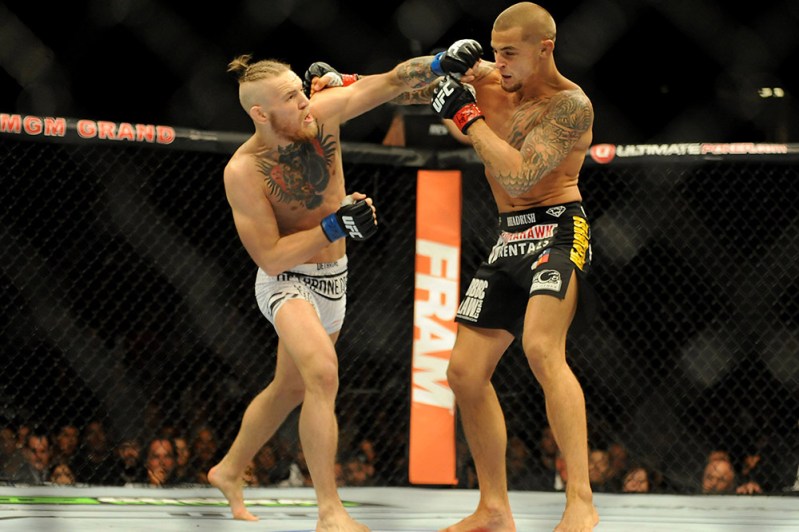
It’s such a simple question, like quarters in football or periods in hockey: How many rounds are in an Ultimate Fighting Championship fight? The answer is harder to answer: It depends on what type of fight and when. While the UFC specifically and mixed martial arts in general are growing year over year in participation, Pay-per-View buys, and ESPN livestreams, along with that growth has come refinements to its rules and structure over the past 27 years. So to answer the question of rounds in a UFC fight, you have to go back to the beginning.
In the beginning, MMA visionary Art Davie created the UFC. Held in Denver, Colo., on November 12, 1993, its structure was set up as a one-night March Madness-style draw, where winning fighters would advance through the bracket until a champion emerged. It was only men, bare knuckles, no holds barred, and minimal rules. There were also no rounds, with fights, in very Fight Club style, lasting as long as they had to until one guy was either knocked out or submitted. It could be incredibly exciting. It also could be a terrific bore.
Related
This lack-of-rounds philosophy showed its fatal flaw at UFC 5 in 1995, when a revenge-hungry Ken Shamrock shot in the first minute on past tournament champ Royce Gracie in a much-hyped Superfight. The two fighters remained prostrate for the next 29 minutes of regulation, jostling for position and glancing ineffectual blows off each other while Shamrock’s balloon-sized muscles grew sweatier. The UFC, panicking, made a field-of-play call to extend a five-minute overtime. Ref John McCarthy even stood the fighters up for a fresh start, but it was no use: Gracie shot first, and though Shamrock clipped him with a right cross that blossomed a mouse below his eye, the fight continued in its established horizontal stalemate for another five minutes before being ruled a draw. The fighters embraced; the crowd booed. Even then, watching it on grainy VHS or Pay-Per-View, it was obvious that the sport had to change.
Over subsequent tournaments, time limits of fights were gradually reduced to a terraced structure that gave earlier rounds less time and grew longer as the fighters ascended via wins. But there were still no formal periods until UFC 21 in 1999, when a round-based system was introduced. Preliminary bouts would consist of two five-minute rounds with a minute rest between; main-card matches, three five-minute rounds; and championships, five five-minute rounds. The event was also the first in which a boxing-like scoring system was introduced, where fighters would be judged on a 10-point system in each round. If the fight “went the distance,” the winner would be decided by tallied scorecards. The round-based structure was formalized in 2000 with the Unified Rules of Mixed Martial Arts, which organizations outside of the UFC also use.
In 2011, UFC President Dana White announced that all headliner matches, regardless of whether a championship was being contended, would be extended five five-minute rounds. Preliminary and main-card matches have been formalized into three rounds. Women, which were first introduced into the UFC in 2012, also observe the same round duration and number as the men following the same structure. And that’s where we stand today.
Recommended Reading
- Do UFC Fighters Wear Cups?
- How Long Is a UFC Fight?
- How Much Do UFC Fighters Get Paid?
- What Does No Contest Mean in UFC?
As with any organization that creates its own rules, you’ll see some variance, and occasionally three-round headliners occur, generally due to unforeseen circumstances like injury or illness. Zabit Magomedsharipov defeated Calvin Kattar in a three-round headliner in 2019 after their match, postponed from a previous card due to injury, was a late add to UFC Fight Night 163 via ESPN+ when its original headliners dropped out due to infection (gross). That same year a match between current middleweight champ Israel Adesanya and former champ Anderson Silva was elevated from a three-round main-card event to a three-round headliner when the initially slated headliner match dropped due to a fighter’s injury. So it goes, and beyond minor grumbling, UFC fans by and large don’t seem to mind whether it goes for five or three as long as they see a competitive fight.
But they might soon. While there are exceptions, including 2019’s Jorge Masvidal TKOing Ben Askren in a fight so short it could be made into a GIF (approximately five seconds), the latest trends show that the majority of fights go the distance and into decision. “The offense of a fighter has always been exceptional and has steadily improved,” writes statistician Ewan Lavender, “but their defense has gone from sometimes non-existent to essential and is the main reason fewer fighters are getting knocked out or submitted.” Therefore, if fans aren’t going to see a knockout, then why wouldn’t they want to see their fighters fight longer?
On Saturday, undefeated middleweight champ Israel Adesanya steps up in weight class to challenge the light heavyweight champ Jan Blachowicz. As it’s a headlining match as well as a championship, it’s slated to run five five-minute rounds. But that’s not how the betting lines figure it. A full five-rounder is a +162 underdog with a predicted stoppage in round three via an Adesanya KO. Blachowicz is a Polish powerhouse on a four-win streak, and all it takes is a split second to end the precision striking of his opponent, the historically lighter fighter.
But if you want our thoughts? Bet on the full five rounds. If the UFC has proven anything over its 27-year history that has traveled from the Mile High City to its own Fight Island, it’s that it’s got what it takes to go the distance.



